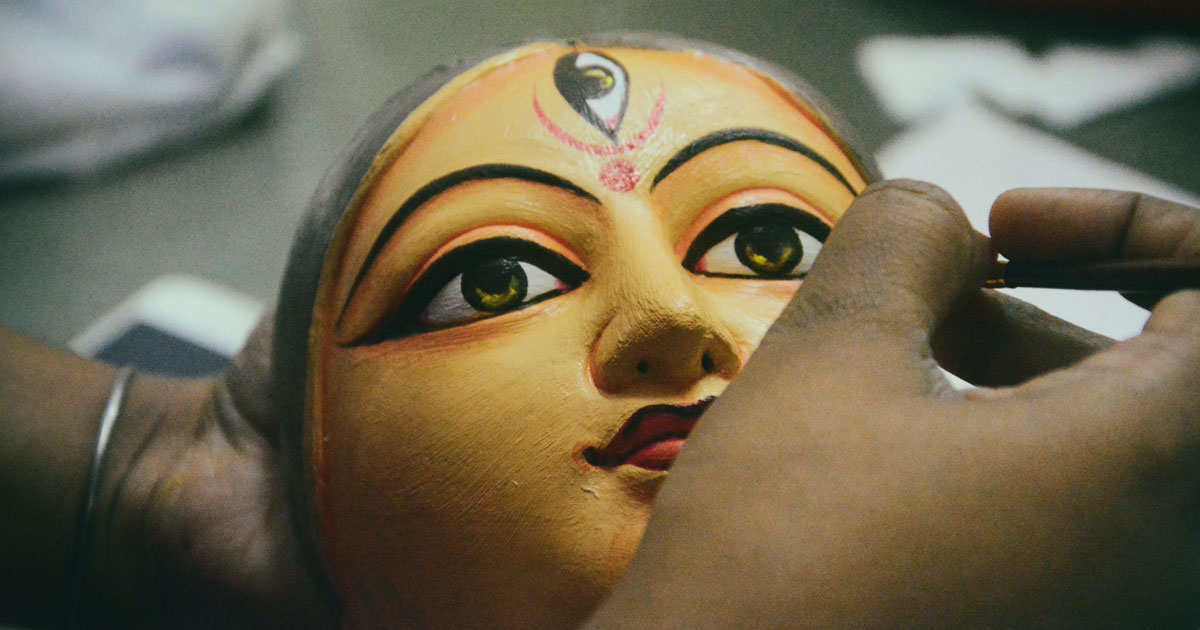It is that time of the year when the festive fever rules high among your Bengali friends. Yes, we are talking about none other than the most celebrated fiesta of Bengal – the Durga Puja. Even the morbidity of the virus could not restrict the happy wave that comes with this festival.
Celebrated in different forms all over the nation like Navaratri in the North, Golu in Tamil Nadu, Durga puja is not just about the lip-smacking ‘bhog’ and the traditional attires. It is filled with exemplary examples of symbolism and female empowerment.
With just a few days remaining to the festival, the arrangements in the pandals, the cheers, and the smiles have me wondering how much we exactly know about this joyous occasion. Is it only about fun and the frolic or do the stories and the folklore have a takeaway?
So let’s have a look at some mind-boggling facts about Durga puja.

1. It’s not even the real Puja!
Yes, you read it right! The actual auspicious time for the Puja is in March where it is known as Basanti Puja. The one that we celebrate now is popularly known in mythology as Akal Bodhon or the untimely sacrifice where Ram invoked the Goddess for her blessings before going on the battle against the Rakshasa Raja Ravan.
2. Inclusivity of all communities
Durga puja is known as Sarbajanin or for everyone for a reason. Did you know that the first handful of clay required for the idol has to be collected from the Nishidho Polli or forbidden area, which in colloquial terms is a brothel?
Not only that, the priest who performs this ritual has to literally beg the Vaishya for the soil as it is considered highly auspicious.
3. Drawing eyes in darkness
Now, this is one contrasting ritual and one of the many mind-boggling factors associated with this puja. Eyes are generally considered as the pathways of light. But you will be surprised to know that the idol maker has to draw the third eye of the Goddess in complete darkness!
This ritual is known as Chokhu Daan and the priest usually undergoes a fast prior to this. Incidentally, never does the work go wrong for the artist, and such is the sheer magic of the divinity.
4. It did not even start in Kolkata
Kolkata may be the hub of Durga puja now, but did you know that it did not begin there?
In fact, the first Durga puja took place in the royal family of Malda, a district in Kolkata. It was only after 1909 that Kolkata caught up with the festive fever.
5. Imported attire for the Goddess
Designer clothes are not modern phenomena. Years ago the mighty Goddess would be adorned with attire from Germany!
The wealthy zamindars of Bengal dressed Durga in glittering silver foils or Daaker Shaaj with posts imported from Germany. Hence a completely novel style was developed which is still very much in vogue today.
6. Invoking the wild
The Goddess is every bit like the accomplished woman – powerful and terrible when provoked. To appease the wild side of her, Sandhi puja is done with an elaborate arrangement of 108 lotuses and 108 lamps.
The ritual of Sandhi Puja which is usually performed in the wee hours of Ashtami has an interesting legend associated with it. It is performed to invoke the wild Chamunda – a blood-curling form of the Goddess who slew the demons Chondo and Munda!
7. An exciting member
Apart from her four children, another very unique member accompanies the Goddess on her visit to the earth. It is none other than the consort of Ganesh, Kola Bou, or the Banana Wife!
Do you know why? Well, several myths say that Ganesh married the Banana so that his mother Durga would not face any hardship under a daughter-in-law.
But keeping the myth aside, this ritual is a beautiful demonstration of the need to worship vegetation amidst so much destruction of the climate.
8. Rituals denoting the empowerment of the girl child
At a time when atrocities against women are on the rise, this Durga puja ritual turns out to be of immense significance.
Started by Swami Vivekananda, the tradition of Kumari puja is done to celebrate the innocence of little girls, thus urging society to accumulate efforts to stop hate crimes against them.
9. Transport troubles
Did you know that the transport chosen by the Goddess to come to earth has some fascinating myths associated with it? The Goddess either travels on an Elephant, a Horse, a Boat, or Palanquin. While the Elephant brings prosperity, the others can cause destruction of crops, floods, or earthquakes respectively.
Talk about transport troubles, these predictions often come true as well!
10. The dark side of it all…
One of the most joyous occasions on the calendar, many believe that the dark-skinned demon Mahisashur represents the defeat of the indigenous people by the fair-skinned foreign invaders. Even though there is no solid proof to support such statements, the symbolism intertwined with the puja leaves it open for interpretation.
The ultimate celebration of the supreme power, Durga puja is more of a socio-cultural event than a religious one, bringing together all communities.

